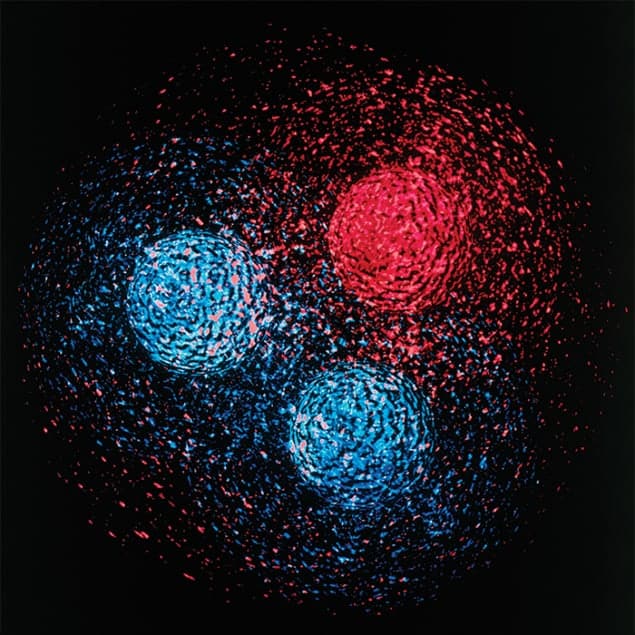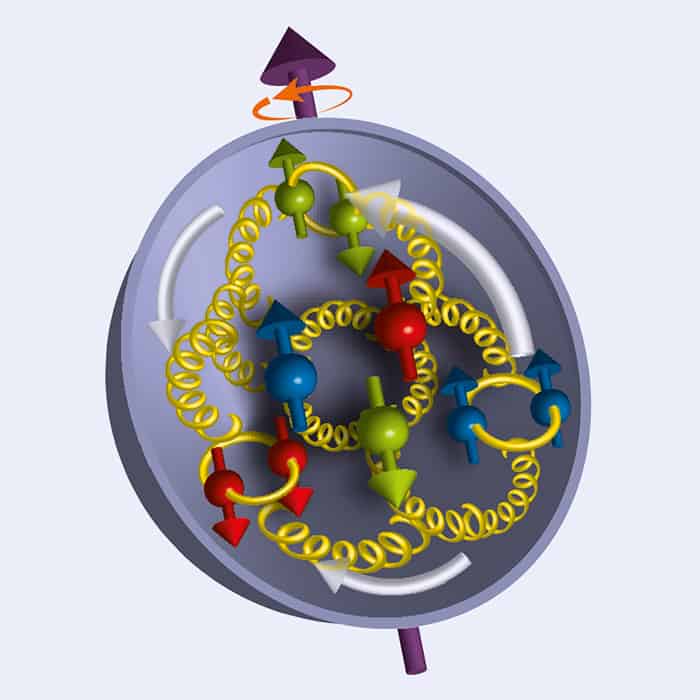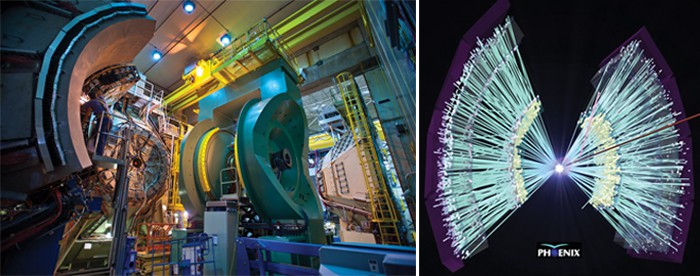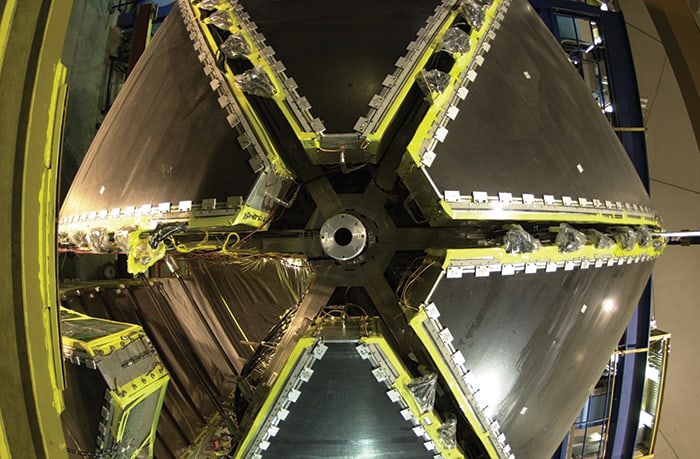For the best part of 30 years physicists have been unable to answer a seemingly simple question: where does proton spin come from? As Edwin Cartlidge reports, the answer may finally be within reach

In physics, the budget always has to be balanced. The amount of any physical quantity on one side of an equation – energy, momentum, charge and so on – must equal that on the other side. Any imbalance means that our understanding of nature might be out of kilter, and may in fact suggest the existence of new laws, particles or forces.
For nearly three decades, physicists have been faced with a particularly stubborn imbalance. At stake is the intrinsic angular momentum, or “spin”, of a proton. Spin is a quantum-mechanical property, akin to the angular momentum of a classical sphere rotating on its axis, except it comes in discrete units of integer or half-integer multiples of ħ. The proton, like the electron and neutron, has a spin of ħ/2, or “spin-1/2”. So do each of its three quarks. Summing the spins of the quarks to get the total spin of the proton seems, in principle, straightforward: if two of the quark spins point up, while the other points down, the down spin will cancel one of the ups, and both sides of the equation should be left with an angular momentum of ħ/2.
Except it isn’t that simple. In 1988 the European Muon Collaboration (EMC) at CERN shocked the physics community by announcing that the sum of the spins of the three quarks that make up the proton is much less than the spin of the proton itself. This was unexpected because the summing-up approach had worked for several of the proton’s other properties. For example, the proton’s electric charge of +1 can be accounted for by adding the charge of its two “up” flavoured quarks (+2/3) to that of its one “down” quark (–1/3). (Note that here, “up” and “down” are names of quarks and have nothing to do with spin.) However, the EMC researchers discovered that the net spin of the three quarks actually accounted for no more than 24% of the proton’s spin, and might even contribute as little as 4% – practically none of it, in other words.
“It was an observation that shocked the world,” says Fred Myhrer of the University of South Carolina in the US. “Everyone was baffled by it. Why should the quark model that had worked so nicely fail so badly?” Indeed, Gerhard Mallot of CERN says that the result threatened to undermine quantum chromodynamics (QCD) – the theory put forward in the early 1970s that describes how the strong nuclear force acts between quarks. “People got nervous,” he recalls. “There were conjectures that the experiment was wrong, or even that QCD was wrong.”
The seriousness of the situation was summed up in the name physicists gave to it: “spin crisis”. Reluctant to ditch the quark model because of its substantial successes, researchers instead devoted their energies to finding alternative sources of the proton spin. There were several possibilities. It could have come from the momentum acquired by quarks and gluons – the particles that carry the strong nuclear force and “glue” the quarks together inside protons and neutrons – as they rotate about the proton’s spin axis. However, this orbital angular momentum is hard to measure. Many researchers instead pinned their hopes on another option: the spin of gluons (figure 1).
Getting good data on gluon spin took nearly 20 years, though, and when that new information finally arrived, it was disappointing. In 2008 physicists working on the Relativistic Heavy Ion Collider (RHIC) at Brookhaven Laboratory on Long Island in New York showed that gluon spin contributes far less to the proton’s spin than had been proposed. The RHIC data followed on the heels of a similar (but less reliable) result obtained by the COMPASS collaboration at CERN two years earlier, so it didn’t look like a fluke. Far from resolving the crisis, the new results threatened to deepen it.
But the RHIC results came with large error bars. For the past seven years, researchers have sought to reduce those errors using an upgraded accelerator and improved detectors. The ensuing data set, which includes results acquired up until 2009, shows that the gluon might, after all, contribute a significant fraction of the proton’s spin. Last year, two groups of theorists who had analysed those data showed that the contribution might in fact approach half of the proton’s spin. One of those theorists, Werner Vogelsang of the University of Tübingen in Germany, argues that the breakthrough provides hope that the enigma of the missing spin might finally be solved.
The limits of theory
Ideally, physicists would like to be able to calculate the proton’s spin (and that of the neutron, which has a similar spin shortfall) from first principles. Unfortunately, QCD is just too complex to permit analytical calculations. The basic problem lies in the enormous strength of the strong nuclear force. Other forces, such as electromagnetism or the weak nuclear force, are puny enough that they can be represented by a fairly simple mathematical expression, to which higher-order corrections are added. But with the strong force, those corrections are themselves large and feed back into the main term.

Such large corrections are needed, in part, to account for the fact that gluons themselves possess “colour”, the QCD equivalent of charge. This means that, unlike photons, which are uncharged, gluons can interact with themselves. Gluons also decay continuously into pairs of quarks and antiquarks, as a consequence of Heisenberg’s uncertainty principle: over very brief periods of time, the uncertainty in mass-energy is very large, which implies that pairs of particles and antiparticles can pop in and out of existence. These very short-lived quark–antiquark pairs can have a significant influence on the behaviour of protons in QCD theory.
The extraordinary complexity of QCD means that physicists must derive many key parameters related to quark matter from experimental measurements, without first being able to predict them theoretically. One of the most important kinds of measurement at their disposal – and the one that prompted the spin crisis – is known as deep-inelastic scattering. This technique involves first firing high-energy electrons (or their more massive cousins, muons; these particles are known collectively as “leptons”) into a target containing certain nuclei, and then measuring the deflection of the leptons as a result of their electromagnetic interaction with two different types of quark: the “valence” quarks within protons and neutrons, and the far more numerous virtual “sea” quarks that are continually appearing and disappearing from the vacuum.
To measure quark spin using deep-inelastic scattering, both the incoming leptons and the target protons must be polarized, so that the spins of the two particle types either line up or oppose one another. Conservation of spin means that leptons can only interact (via the exchange of a spin-1 photon) with quarks of opposing spin. So by firing leptons first polarized in one direction and then the other, and recording the number of deflections in each case, scientists can work out the imbalance in quark spin and discover whether or not it adds up to the ħ/2 needed to account for the spin of the proton.
The first such measurements were carried out at the Stanford Linear Accelerator Center (SLAC) in California in the late 1970s. These measurements showed that quarks contribute about 60% of the proton’s spin, which was not surprising, since relativistic effects had already been predicted to transform some of the quark spin into orbital angular momentum. This transformation happens because quarks are confined in a small space inside the proton, and according to the uncertainty principle, this implies that those quarks have significant momentum perpendicular to, as well as along, their direction of motion. This means the quarks gyrate, and they do so at relativistic speeds because of their small mass.
The SLAC experiment, however, was limited by having a relatively low-energy beam – of no more than 20 GeV. Energy is a crucial parameter in scattering experiments because higher energies correspond to shorter wavelengths and therefore higher resolutions. And the higher the resolution, the more dense is the sea of virtual quarks and gluons visible inside the proton – given that quarks radiate gluons that split into quark–antiquark pairs, which then emit further gluons, and so on. That ever higher density in turn means an ever greater parcelling up of the proton’s energy, which means that each particle carries an ever smaller momentum. Since quark spin has to be integrated across quarks of all momenta, higher-energy probes provide a better estimate of the total contribution of all quarks to the spin of the proton – from the most energetic valence quarks to the lowliest sea quarks.
This is where the EMC had the edge. By firing a beam of muons into an ammonia target, it was able to reach energies of 200 GeV and so probe quarks with much lower momenta. As it happened, the spin of these quarks did not contribute as much to the total proton spin as was expected from an extrapolation of the SLAC data – making the overall quark-spin contribution far lower than previously thought. This stunning result has since been confirmed by other scattering experiments at SLAC, CERN, the DESY laboratory in Germany and the Jefferson laboratory in Virginia. The combined data from these experiments indicate that quark spin contributes about 30(+/–5)% of the proton’s spin – a bit more than the EMC’s initial results had suggested, but still much less than the total.
Gluons vs orbital motion
With the quark-spin contribution thus pinned down, attention turned to the remaining 65–75% of unaccounted-for proton spin. Most physicists think that this is shared out between three contributing phenomena: the quarks’ orbital angular momenta, the gluons’ spin and the gluons’ orbital angular momenta. (Photons might also play a part, but their contribution is expected to be very small, if not zero.) However, there remain differences of opinion as to how big each of these components is likely to be.

Anthony Thomas of the University of Adelaide in Australia claims that practically all of the remaining fraction can be accounted for via the conversion of quark spin into quark and antiquark orbital angular momenta. His assertion is based on a model that treats the proton as a “bag” of three quarks surrounded by a cloud of pions, which are very short-lived particles with a quark–antiquark core. Thomas says that in this “cloudy-bag” model, the effects of three phenomena add up to generate the required spin-to-orbital angular momentum conversion: one, the relativistic movement of quarks; two, the exchange of gluons when quarks interact; and three, a proton’s brief “fluctuation” into a proton or neutron plus a pion (any flipping of the proton spin results in the pion carrying away orbital angular momentum).
Initially, results derived from this model disagreed with the predictions of another technique, known as lattice QCD, which allows some properties of protons to be computed by breaking down space and time into discrete units. But Thomas realized that lattice QCD considers protons at very different energies (and hence resolutions) from those typically used in the cloudy-bag model. Once this energy difference is accounted for, he says, the two approaches yield similar results.
Other theorists, however, think that gluons could still make a substantial contribution. Robert Jaffe of the Massachusetts Institute of Technology in the US argues that “there is no reason a priori” to think that any of the potential spin components can be neglected, and Vogelsang argues that gluon spin “could easily” contribute more than orbital angular momentum. In Vogelsang’s view, the cloudy-bag model might explain why the quark-spin contribution is so small, but he is not convinced that it can then go on to explain where the missing spin comes from.
According to Vogelsang, a “crisis mood” surrounding the hunt for the missing proton spin prevailed until last year, when the latest round of RHIC results lifted it. RHIC collides two beams of polarized protons, and (as in the earlier, lepton-based deep-inelastic scattering experiments) it makes measurements with the spins of the beams aligned and then anti-aligned. However, whereas leptons cannot scatter off gluons directly because they do not feel the strong force, the colliding RHIC beams produce plenty of interactions involving quarks and/or gluons, thus providing direct information about gluon spin.
Using data from RHIC’s STAR and PHENIX detectors, Vogelsang and colleagues from Tübingen and Buenos Aires pinned down the gluon spin contribution to be about 40%. A separate group, led by Emanuele Nocera of the University of Milan in Italy, concluded it was about 34%. Further data from RHIC (collected between 2011 and 2015) will allow theorists to refine these estimates further.
Energy boost
With these confident estimates in, one might expect that only a third of the proton’s spin remains up for grabs. However, Renee Fatemi, a physicist at the University of Kentucky in the US and deputy spokesperson of the STAR collaboration, points out that there are still some lingering questions about gluon spin. As was the case with quark spin, she says, gluons’ spin contributions must be summed across all momenta – and RHIC’s collision energies of 500 GeV are not quite energetic enough to probe gluons at the lowest end of the momentum scale. Doing that, she says, will require a new machine: the Electron–Ion Collider (EIC).
The EIC would combine the punch of proton-beam experiments with the precision of electrons. In proton-beam experiments, the actual collisions take place between individual quarks, not whole protons, and each quark carries only a fraction of the proton’s energy. In contrast, electrons are point particles, so they deliver all of the energy they acquire through acceleration. This means that in electron-beam experiments, collision energies are actually higher even though the combined energy of the two beams is lower.

There are currently two designs on the table for the roughly $1bn EIC: one involving the addition of an electron beam facility at RHIC and the other requiring the construction of an ion accelerator at the Jefferson Lab. Either incarnation would eventually reach collision energies in the region of 140 GeV, but would not switch on until 2025 at the earliest.
According to Elke-Caroline Aschenauer of the Brookhaven lab, the EIC should provide the last word on proton spin. Not only will it reach all the way down to the lowest gluon momenta of interest, she argues, it will also constrain models that describe quarks’ and gluons’ orbital angular momenta. “I think after the EIC you will have the spin puzzle solved,” she says. “If the EIC doesn’t solve it then the proton would have to get its spin from something other than quarks, gluons and orbital angular momentum. And that would be extremely surprising.”
Thomas, however, believes that the spin puzzle has already been solved – in favour of quark and antiquark orbital angular momenta. He acknowledges that the gluon spin contribution has “got a bit bigger” in the light of the latest RHIC data, but argues that this is “only half the story”. He maintains that gluons’ true contribution to proton spin remains unclear because, he says, at higher energies, where their spin contribution increases, their angular momentum contribution actually goes down. “There are many interesting experiments that an electron–ion collider can do, such as sorting out the spin carried by various flavours of quarks and antiquarks,” he explains. “But solving the spin crisis is not one of them.”
Myhrer, who worked on the cloudy-bag model with Thomas, also believes that gluon spin is the wrong place to look. He argues that it is not possible to separate out the spin and orbital angular momentum contributions provided by the strong-force carrier. But he is not quite as bullish as his Australian colleague. “My opinion on this as a theorist is quite firm – yes, angular momentum due to the gyration of the quarks accounts for a large fraction of the missing spin,” says Myhrer. “However, only future experiments can settle these ongoing arguments”.
Vogelsang agrees that more data are needed to settle the issue. Indeed, he points out that, while unlikely, it is still possible that slow-moving gluons have their spins aligned against that of the proton, thereby reducing gluons’ contribution or even cancelling it altogether. “Models tend to predict that gluon spin is aligned at low momenta but we don’t have a clear proof of that,” he says. “The only thing to do is to push experiments down to these scales and see what happens there. There might still be surprises lurking.”



